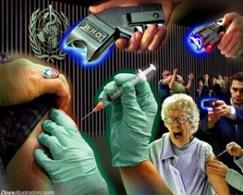Active vocabulary of the text.
| Chagas disease | болезнь Чагаса, американский трипаносомоз | |
| headquarters | [hed'kwɔ:təz] | штаб-квартира, головной офис, главное управление (компании, организации) |
| eradication | [ərædɪ'keɪʃ(ə)n] | искоренение, уничтожение |
| elimination | [əlɪmɪ'neɪʃ(ə)n] | устранение; уничтожение, ликвидация |
| stark | [sta:k] | сильный, неистовый; строгий, суровый |
| biodegradable | [baɪəudɪ'greɪdəbəl] | разлагаемый микроорганизмами |
| sanitation | [sænɪ'teɪʃ(ə)n] | оздоровление, улучшение санитарных условий; санитария |
Exercise 8: Read the text:
World Health Organization came into being on April 7, 1948 with its headquarters at Geneva in Switzerland.
 World Health Organizationhas completed more than fifty years of service to mankind, its achievements have been greater but the challenges facing it are greater. One of the World Health Organization’s greatest success stories in this century is the total eradication of smallpox, saving many lives around the world and many people from its crippling effects. The other great success includes the eradication of gunieaworm disease. Since August 1996 India has reported zero incidences. Yemen is the last country outside Africa which still reported rare cases in 1997. By 2000, the disease was traceless.
World Health Organizationhas completed more than fifty years of service to mankind, its achievements have been greater but the challenges facing it are greater. One of the World Health Organization’s greatest success stories in this century is the total eradication of smallpox, saving many lives around the world and many people from its crippling effects. The other great success includes the eradication of gunieaworm disease. Since August 1996 India has reported zero incidences. Yemen is the last country outside Africa which still reported rare cases in 1997. By 2000, the disease was traceless.
Poliomyelitis or polio that has been crippling our children is on the verge of eradication. Leprosy that makes man virtually untouchable has been eliminated. The World Health Assembly targeted leprosy for global elimination in 1991 by the year 2000. Since then significant progress has been achieved throughout the world, including a 98 per cent reduction in the number of registered cases. Similarly the number of endemic countries has shrunk to 55 from 122 in 1997.
Another step towards achieving success is that the 32-strong executive board of the World Health Organizationwhich began its 101st session in January, 1998 will consider progress towards elimination of two major tropical diseases leprosy and Chagas. The economic loss suffered by this disease due to early mortality and disability amounts to $ 8,200 million a year. The year 2010 has been marked to eliminate this disease. Globally life expectancy has increased to 68 in 1998 from 46 in the 1950s.
 The deaths in newborns have dropped. Oral rehydration therapy has reduced deaths due to cholera and other diarrheal diseases. Infant mortality has halved in 30 years to 50 deaths per 1000 live births. In 1990 women were having 3.2 babies on an average per family. And 8 out of 10 children are now immunized against killer diseases like measles. The tale of infectious diseases does not end here. A World Health Organizationpress release of January 1998 highlighted the stark reality that 3 billion people worldwide lacked sanitation facilities. World Health Organizationwarns ‘the poorest 1000 million people are seven times more likely to die from infectious diseases and maternal and prenatal conditions most of which are related to bad sanitation for those that are the poorest.’
The deaths in newborns have dropped. Oral rehydration therapy has reduced deaths due to cholera and other diarrheal diseases. Infant mortality has halved in 30 years to 50 deaths per 1000 live births. In 1990 women were having 3.2 babies on an average per family. And 8 out of 10 children are now immunized against killer diseases like measles. The tale of infectious diseases does not end here. A World Health Organizationpress release of January 1998 highlighted the stark reality that 3 billion people worldwide lacked sanitation facilities. World Health Organizationwarns ‘the poorest 1000 million people are seven times more likely to die from infectious diseases and maternal and prenatal conditions most of which are related to bad sanitation for those that are the poorest.’
Most of the excreta are recycled for use in agriculture or deposited on land without prior destruction of pathogens, most of which eventually enter the surface and ground waters, sometimes surviving for considerable length of time. Not surprisingly diseases such as diarrheal diseases and hepatitis are endemic in those areas.
